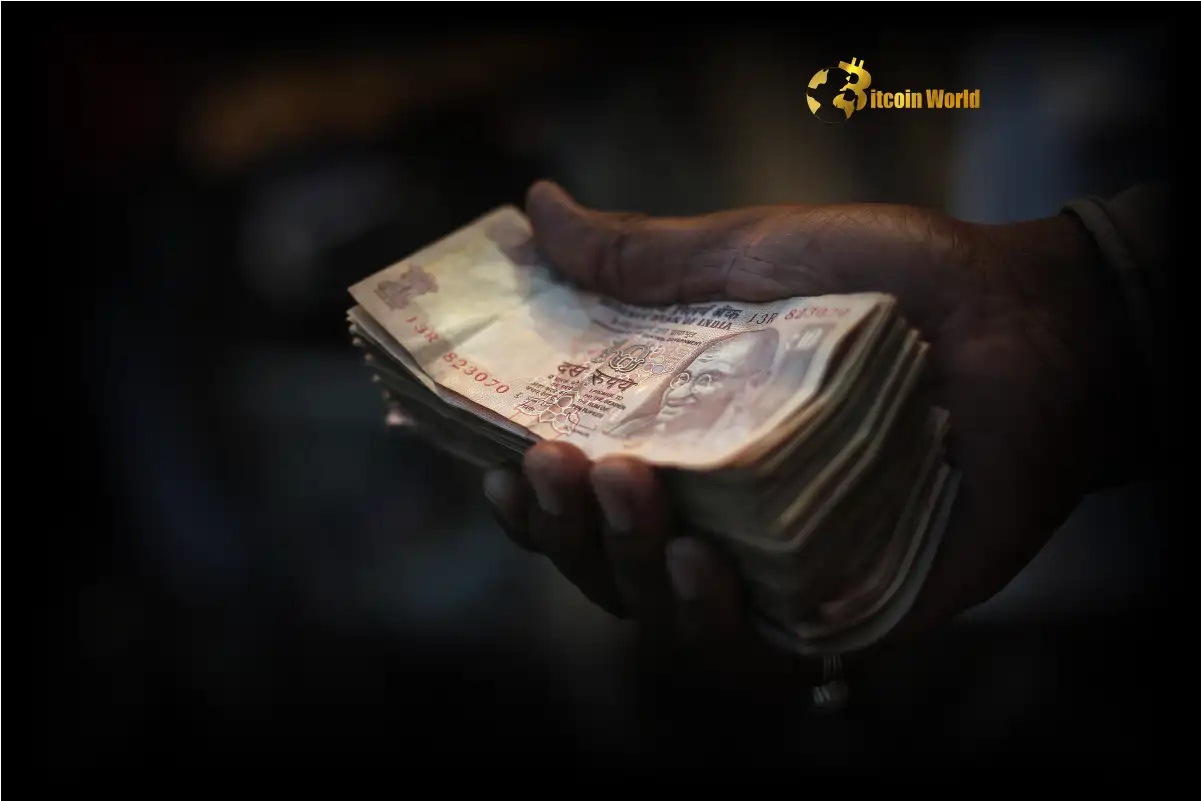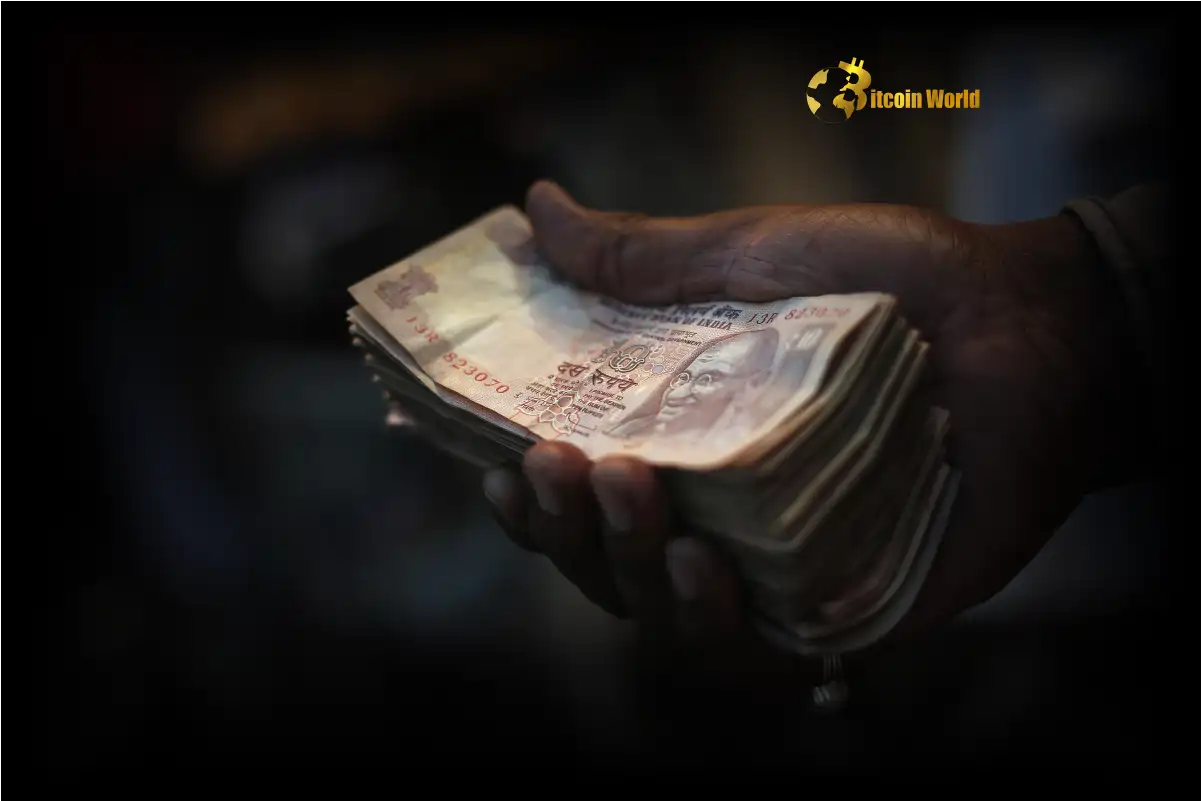In the fast-paced world of cryptocurrency and digital assets, where volatility is often the name of the game, the stability of traditional currencies can seem like a distant concept. Yet, understanding the dynamics of fiat currencies, especially in the face of global economic shifts, offers crucial insights into broader market trends that can indirectly impact the crypto sphere. Today, we’re diving into a fascinating case study: the Indian Rupee holding its ground amidst a significant market dip triggered by renewed US tariffs. Is this just a fleeting moment of calm, or does it signal deeper economic resilience? Let’s explore the factors at play and what this means for the global financial landscape.
Why is Currency Stability Important in Today’s Volatile Market?
In an era defined by rapid technological advancements and interconnected global economies, currency stability acts as a bedrock of financial confidence. For traders, investors, and even everyday citizens, a stable currency offers predictability and reduces the anxieties associated with fluctuating values. But why is this so critical, especially now?
- Predictability for Businesses: Imagine a business importing goods. If their home currency is highly volatile, budgeting and pricing become nightmares. Stable currencies allow businesses to plan effectively, manage costs, and ensure consistent profitability.
- Investor Confidence: Investors, both domestic and international, are drawn to economies with stable currencies. It signals sound economic management and reduces the risk of currency devaluation eroding investment returns. This is particularly relevant in attracting Foreign Direct Investment (FDI), which is vital for economic growth.
- Reduced Inflationary Pressures: A depreciating currency makes imports more expensive, potentially leading to imported inflation. Currency stability helps to keep inflation in check, preserving the purchasing power of consumers and maintaining economic equilibrium.
- Debt Management: For countries with significant foreign currency debt, a stable domestic currency is crucial. A sharp depreciation can make debt servicing much more expensive, potentially leading to financial distress.
In the cryptocurrency world, while volatility is often seen as an opportunity, the underlying stability of fiat currencies and the global financial system still plays a significant role. Major economic events impacting fiat currencies can create ripple effects across all markets, including crypto. Understanding these dynamics is crucial for informed decision-making in the digital asset space.
The US Tariff Trigger: What Caused the Market Dip?
The global economy is a complex web of interconnected factors, and trade policies enacted by major economies like the United States can send ripples across the world. Recently, the re-imposition of US tariffs on certain goods has become a significant catalyst for market dip. But how exactly do these tariffs lead to market instability?
When the U.S. imposes tariffs on imports, it essentially increases the cost of these goods for American consumers and businesses. This can lead to several consequences:
- Trade Tensions Escalate: Tariffs are often seen as protectionist measures and can provoke retaliatory tariffs from other countries. This tit-for-tat can escalate into trade wars, creating uncertainty and dampening global economic sentiment.
- Supply Chain Disruptions: Businesses with global supply chains may face increased costs and disruptions as they adjust to the new tariff regime. This can impact production, profitability, and overall market confidence.
- Market Uncertainty: The imposition of tariffs introduces uncertainty into the market. Investors become wary of potential economic slowdowns, reduced corporate earnings, and broader economic instability. This uncertainty often leads to sell-offs in equity markets, contributing to a market dip.
- Currency Fluctuations: Trade tensions and economic uncertainty can also lead to fluctuations in currency values. Investors may seek safe-haven assets, impacting the demand and supply dynamics of various currencies.
In the context of the recent market dip, concerns over renewed US tariffs have played a significant role in unsettling investor sentiment. This global economic uncertainty provides the backdrop against which the Indian Rupee’s performance becomes particularly noteworthy.
Indian Rupee’s Resilience: Holding Steady Amidst the Storm
While global markets grappled with the fallout from renewed US tariffs, the Indian Rupee has demonstrated remarkable resilience, holding relatively steady against major currencies. This stability is not just a matter of luck; it’s a result of a combination of factors reflecting India’s economic fundamentals and strategic policy decisions. What are these factors contributing to the Indian Rupee’s surprising strength?
- Robust Economic Growth: India remains one of the fastest-growing major economies in the world. This strong economic growth provides a solid foundation for the Indian Rupee, attracting foreign investment and bolstering confidence in the currency.
- Healthy Foreign Exchange Reserves: The Reserve Bank of India (RBI) has built up substantial foreign exchange reserves. These reserves act as a buffer, allowing the RBI to intervene in the forex market to manage volatility and support the Indian Rupee when needed.
- Prudent Monetary Policy: The RBI has maintained a relatively prudent monetary policy, focused on controlling inflation and maintaining macroeconomic stability. This approach has instilled confidence in investors and contributed to currency stability.
- Strong Domestic Demand: India’s large and growing domestic market provides a degree of insulation from external shocks. Strong domestic demand supports economic activity and reduces reliance on exports, making the economy and the Indian Rupee less vulnerable to global trade tensions.
- Capital Inflows: Despite global uncertainties, India continues to attract capital inflows, both in terms of foreign direct investment and portfolio investments. These inflows support the demand for the Indian Rupee and contribute to its stability.
This confluence of factors has allowed the Indian Rupee to weather the storm of global market volatility triggered by US tariffs, standing out as a beacon of stability in a turbulent financial landscape.
Benefits of a Stable Rupee: Impact on the Indian Economy and Beyond
The Indian Rupee’s currency stability in the face of global economic headwinds offers a range of benefits, not just for the Indian economy but also for international trade and investment. Let’s explore some key advantages:
- Reduced Import Costs: A stable or appreciating Rupee makes imports cheaper in local currency terms. This is particularly beneficial for India, which is a major importer of commodities like crude oil. Lower import costs can help to keep inflation under control and reduce the burden on consumers and businesses.
- Lower External Debt Burden: For Indian companies and the government with foreign currency debt, a stable Rupee means a reduced debt burden in local currency terms. This can free up resources for productive investments and reduce financial risks.
- Enhanced Investor Confidence: Currency stability enhances investor confidence in the Indian economy. It signals macroeconomic stability and sound economic management, attracting further foreign investment and boosting economic growth.
- Improved Creditworthiness: A stable currency can improve India’s creditworthiness in international markets. This can lead to lower borrowing costs for the government and Indian companies when they access international capital markets.
- Support for Forex Market Confidence: The resilience of the Indian Rupee can contribute to overall confidence in the forex market, particularly in emerging market currencies. It demonstrates that sound economic fundamentals and prudent policies can provide a buffer against global economic shocks.
For cryptocurrency enthusiasts, the stability of a major emerging market currency like the Indian Rupee highlights the importance of macroeconomic factors in the broader financial ecosystem. While crypto markets operate with their own dynamics, they are not entirely immune to global economic trends and currency movements.
Challenges and Considerations: Can the Rupee Maintain its Course?
While the Indian Rupee has shown impressive resilience, it’s crucial to acknowledge that challenges and potential risks remain. The global economic landscape is constantly evolving, and several factors could test the Rupee’s currency stability in the future. What are some of these potential headwinds?
- Global Economic Slowdown: A significant global economic slowdown could impact India’s exports and capital inflows, potentially putting downward pressure on the Indian Rupee.
- Geopolitical Risks: Escalating geopolitical tensions, such as trade wars or regional conflicts, could increase risk aversion and lead to capital outflows from emerging markets like India, impacting the Rupee.
- Domestic Economic Challenges: While India’s economic growth is robust, domestic challenges such as inflation, fiscal deficits, and structural issues could pose risks to currency stability if not effectively managed.
- Changes in US Monetary Policy: Aggressive interest rate hikes by the US Federal Reserve could strengthen the US dollar and potentially lead to capital outflows from emerging markets, putting pressure on currencies like the Indian Rupee.
- Commodity Price Volatility: As a major oil importer, India is vulnerable to fluctuations in global crude oil prices. A sharp spike in oil prices could widen India’s trade deficit and put downward pressure on the Indian Rupee.
Maintaining currency stability is an ongoing effort. The RBI and the Indian government need to remain vigilant and proactive in managing these potential risks through sound economic policies and strategic interventions.
Actionable Insights: What Can We Learn from the Rupee’s Performance?
The Indian Rupee’s performance amidst the US tariff-induced market dip offers valuable lessons for investors, policymakers, and anyone interested in understanding global financial dynamics. What are the key takeaways?
- Economic Fundamentals Matter: Strong economic fundamentals, such as robust growth, healthy reserves, and prudent policies, are crucial for currency stability, especially in times of global uncertainty.
- Diversification is Key: For investors, the Rupee’s resilience highlights the importance of diversification. Relying solely on one asset class or market can be risky. A diversified portfolio that includes exposure to different currencies and economies can help to mitigate risk.
- Monitor Global Economic Trends: Understanding global economic trends, including trade policies, geopolitical events, and monetary policy shifts, is essential for making informed financial decisions. These factors can have a significant impact on currency values and market movements.
- Emerging Markets Can Offer Stability: While often perceived as riskier, some emerging markets, like India, can offer surprising resilience and stability. Careful analysis of economic fundamentals and policy frameworks can uncover valuable investment opportunities.
- Currency Stability is a Sign of Economic Health: For policymakers, the Rupee’s performance underscores the importance of prioritizing macroeconomic stability. Currency stability is not just a goal in itself; it’s a reflection of broader economic health and a foundation for sustainable growth.
For those in the cryptocurrency space, observing the resilience of the Indian Rupee can provide a valuable perspective. While the crypto market is driven by different forces, the underlying principles of economic stability, investor confidence, and global interconnectedness are relevant across all financial markets.
Conclusion: A Beacon of Resilience in a Turbulent World
In a world increasingly characterized by volatility and uncertainty, the Indian Rupee’s steadfast performance amidst a market dip triggered by US tariffs is a compelling story of economic resilience. It underscores the importance of sound economic fundamentals, prudent policy-making, and the inherent strength of a large and growing economy. While challenges remain, the Rupee’s ability to hold its ground offers a powerful message of stability and confidence in the face of global economic headwinds. This resilience not only benefits the Indian economy but also contributes to a more stable and predictable global forex market, offering valuable lessons for all participants in the interconnected world of finance.
To learn more about the latest forex market trends, explore our articles on key developments shaping global currency dynamics and macroeconomic trends.






